MYB elongation is regulated by the nucleic acid binding of NFκB p50 to the intronic stem-loop region
- PMID: 25853889
- PMCID: PMC4390348
- DOI: 10.1371/journal.pone.0122919
MYB elongation is regulated by the nucleic acid binding of NFκB p50 to the intronic stem-loop region
Abstract
MYB transcriptional elongation is regulated by an attenuator sequence within intron 1 that has been proposed to encode a RNA stem loop (SLR) followed by a polyU tract. We report that NFκBp50 can bind the SLR polyU RNA and promote MYB transcriptional elongation together with NFκBp65. We identified a conserved lysine-rich motif within the Rel homology domain (RHD) of NFκBp50, mutation of which abrogated the interaction of NFκBp50 with the SLR polyU and impaired NFκBp50 mediated MYB elongation. We observed that the TAR RNA-binding region of Tat is homologous to the NFκBp50 RHD lysine-rich motif, a finding consistent with HIV Tat acting as an effector of MYB transcriptional elongation in an SLR dependent manner. Furthermore, we identify the DNA binding activity of NFκBp50 as a key component required for the SLR polyU mediated regulation of MYB. Collectively these results suggest that the MYB SLR polyU provides a platform for proteins to regulate MYB and reveals novel nucleic acid binding properties of NFκBp50 required for MYB regulation.
Conflict of interest statement
Figures
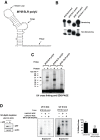
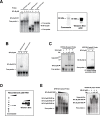
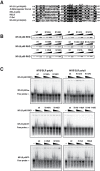

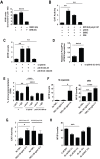
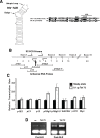


Similar articles
-
Human immunodeficiency virus type 1 LTR TATA and TAR region sequences required for transcriptional regulation.EMBO J. 1989 Mar;8(3):765-78. doi: 10.1002/j.1460-2075.1989.tb03437.x. EMBO J. 1989. PMID: 2721501 Free PMC article.
-
Members of the nuclear factor kappa B family transactivate the murine c-myb gene.J Biol Chem. 1995 Mar 31;270(13):7661-71. doi: 10.1074/jbc.270.13.7661. J Biol Chem. 1995. PMID: 7706314
-
HIV-1 regulatory protein tat induces RNA binding proteins in central nervous system cells that associate with the viral trans-acting-response regulatory motif.J Hum Virol. 1999 Mar-Apr;2(2):72-80. J Hum Virol. 1999. PMID: 10225209
-
Face-time with TAR: Portraits of an HIV-1 RNA with diverse modes of effector recognition relevant for drug discovery.J Biol Chem. 2019 Jun 14;294(24):9326-9341. doi: 10.1074/jbc.REV119.006860. Epub 2019 May 12. J Biol Chem. 2019. PMID: 31080171 Free PMC article. Review.
-
Tackling Tat.J Mol Biol. 1999 Oct 22;293(2):235-54. doi: 10.1006/jmbi.1999.3060. J Mol Biol. 1999. PMID: 10550206 Review.
Cited by
-
N-Terminal Truncated Myb with New Transcriptional Activity Produced Through Use of an Alternative MYB Promoter in Salivary Gland Adenoid Cystic Carcinoma.Cancers (Basel). 2019 Dec 21;12(1):45. doi: 10.3390/cancers12010045. Cancers (Basel). 2019. PMID: 31877778 Free PMC article.
-
The mechanism of MYB transcriptional regulation by MLL-AF9 oncoprotein.Sci Rep. 2019 Dec 27;9(1):20084. doi: 10.1038/s41598-019-56426-7. Sci Rep. 2019. PMID: 31882723 Free PMC article.
-
Adenoid cystic carcinoma: emerging role of translocations and gene fusions.Oncotarget. 2016 Oct 4;7(40):66239-66254. doi: 10.18632/oncotarget.11288. Oncotarget. 2016. PMID: 27533466 Free PMC article. Review.
-
Transcription regulation of MYB: a potential and novel therapeutic target in cancer.Ann Transl Med. 2018 Nov;6(22):443. doi: 10.21037/atm.2018.09.62. Ann Transl Med. 2018. PMID: 30596073 Free PMC article. Review.
-
Leprosy drug clofazimine activates peroxisome proliferator-activated receptor-γ and synergizes with imatinib to inhibit chronic myeloid leukemia cells.Haematologica. 2020 Apr;105(4):971-986. doi: 10.3324/haematol.2018.194910. Epub 2019 Aug 1. Haematologica. 2020. PMID: 31371410 Free PMC article.
References
Publication types
MeSH terms
Substances
Grants and funding
LinkOut - more resources
Full Text Sources
Other Literature Sources
Research Materials

